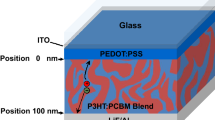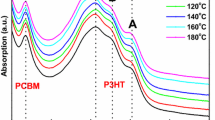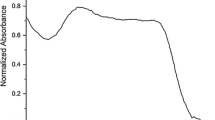Abstract
We investigate the influence of different electron-to-hole mobility ratios on the performance of a P3HT:PCBM bulk heterojunction organic solar cell by using numerical simulations. We show that in some particular mobility cases using a ratio between electron and hole mobility higher than one can improve power conversion efficiency.
Similar content being viewed by others
Avoid common mistakes on your manuscript.
1 Introduction
Following intensive research and development during the last decade, organic solar cells (OSCs) have shown important improvements. Currently, the most efficient class of polymer-based solar cells are based on bulk heterojunction, which consists of a blend of donor and acceptor materials mixed in a solution that forms two interpenetrating networks. To date, the blend of poly (3-hexylthiophene) (P3HT) and 6,6-phenyl C61-butyric acid methyl ester (PCBM), which has demonstrated power conversion efficiency over 5 % (Ma et al. 2005; Irwin et al. 2008), is one of the most intensively studied active material systems for bulk heterojunction solar cells due to the efficient dissociation of excitons and high carrier mobility.
Recently, several studies have focused on the development of more efficient organic solar devices, which have led to research of charge carrier mobility because attempting to optimize power conversion efficiency requires collecting as many photogenerated carriers as possible from the electrodes of the solar cell. The collection of charge carriers depends on their mobility and recombination.
It is well known that while the short-circuit current density grows with increasing mobility in OSCs under illumination, the open circuit voltage decreases (Deibel et al. 2008). Due to the power conversion efficiency is a trade-off between voltage and photocurrent, there must be an optimum value of carrier mobility which ensures the highest efficiency and performance. Some previous studies have focused on determining the optimum conditions by assuming that the electron and hole mobilities are equal to each other (Deibel et al. 2008; Tress et al. 2012).
In this study, a theoretical analysis of the electrical parameters of a P3HT:PCBM-based Solar Cell for four electron-to-hole mobility ratios (\({\beta }\)) is presented. We show that short circuit current density does not change with increasing \({\beta }\) as the open circuit voltage decreases. We also report that the maximum power point \((P_{max})\) of the solar cell was achieved by choosing \({\beta } = 10\).
2 Models and methods
Since the electrical model of organic solar cells used in this article has already been detailed by Koster et al. (2005), it is only partially described in this section.
If the carrier diffusion coefficients obey the Einstein relation, the electron and hole currents incorporating both drift and diffusion of charge carriers are given by
where \(q\) is the elementary charge, \(\varphi (x)\) the electrostatic potential, \(p(x)\) the hole density, \(n(x)\) the electron density, \({\mu }_{n}\) the electron mobility, \({\mu }_{p}\) the hole mobility, \(k_{B}\) the Boltzmann’s constant, and \(T\) the absolute temperature.
Recently, it has been demonstrated that non-geminate recombination in disordered organic semiconductors can be described by free-to-trap carrier recombination (Kirchartz et al. 2011; MacKenzie et al. 2011, 2012). In this study for simplicity we neglect the presence of carrier trap states and use the classical Langevin recombination approximation (Koster et al. 2005, Deibel et al. 2008, Tress et al. 2012). By using the Langevin theory, the bimolecular recombination of charge carriers is given by
where \(n_{\mathrm{int}}\) is the intrinsic carrier density and \({\gamma }\) is the recombination constant determined by the minimum mobility as
with the dielectric constant of organic blend \(\varepsilon \).
We define the electron-to-hole mobility ratio \({\beta }\) as:
To simulate the performance of the organic solar cell, the system of the equations were solved numerically.
3 Results and discussion
For this study, we used the same physical parameters of an organic solar cell already reported by Namkoong et al. (2010), which corresponds to BHJ solar cells consisting of P3HT as the hole conductor and fullerene derivative PCBM as the electron conductor. Table 1 lists the physical parameters used in the simulation.
To investigate the effects of \({\beta }\) on the electrical properties of the solar cell, we vary the hole mobility from \(1\times 10^{-8}\) to \(1\times 10^{8}\,\hbox {cm}^{2}/\hbox {Vs}\) and simulate four cases: \({\beta } = 1\), \({\beta } = 10\), \({\beta } = 100\), and \({\beta } = 1000\).
As shown in Fig. 1, we have found that the short circuit current density of the solar cell does not show any significant change in magnitude with higher ratios. Since the recombination constant of the Langevin recombination model depends only on the lowest mobility and since the increment of \({\beta }\) implies only the increment of the electron mobility causing that the hole mobility remains as the lowest one in the four cases of study, a strong relation between the recombination process and short circuit current density can be observed. In other words, the main process involved in determining the short circuit current density is the recombination. Another point to highlight related to short circuit current density is that, for mobilities of approximately \(1\times 10^{2}\,\hbox {cm}^{2}\)/Vs and higher, the magnitude seems to be constant, which supports the theory of optimum charge carrier mobility.
As shown in Fig 1a, open circuit voltage magnitude appears to decrease with higher mobilities and ratios, except for the interval \(1\times 10^{-8}\,\hbox {cm}^{2}/\hbox {Vs}<{\mu }_{p}\,< 1\times 10^{-5}\,\hbox {cm}^{2}/\hbox {Vs}\), in which the magnitude for \({\beta } = 10\) and \({\beta } = 100\) is higher than the magnitude for \({\beta } = 1\). This tendency to decrease is strictly related to the way in which the model of the solar cell considers the separation distances of the electron and hole, as variable electron-hole pair separation considerably influences the open circuit voltage. Kirchartz et al. (2009) better explain this phenomenon.
Although Fig. 1 a suggests the electrical properties of the solar cell, we cannot discern whether power conversion efficiency improves with higher electron-to-hole mobility ratios, for the short circuit current density shows increment while the open circuit voltage decreases with higher mobilities. In order to better understand power conversion efficiency, we have calculated the point of maximum power of the solar cell, as shown in Fig. 1b.
At first look, the behavior of \(P_{max}\) agrees with recently published studies about the existence of an optimum mobility (Tress et al. 2012). As shown in Fig. 1b, not only the mobility value but also the electron-to-hole mobility ratio is significant to producing optimum efficiency. The optimum point of maximum power can be obtained by choosing \(\beta = 10\), unlike that stipulated by Kotlarski and Blom (2012), which has concluded that for unbalanced charge transport, the overall performance of the organic solar cell worsens. For example, when the lowest mobility (i.e., either of the electron or the hole) is lower than \(1\,\hbox {cm}^{2}/\hbox {Vs}\), a higher ratio can be observed to improve the maximum power point. On the other hand, if the lowest mobility is higher than \(1\hbox {cm}^{2}/\hbox {Vs}\), a ratio of one would be enough to obtain the highest \(P_{max}\). As shown in Fig. 2, the maximum power point is represented by the trade-off between the increment of the current density and the decrement of the electric potential difference. In this study, the highest point of maximum power \((4.9122\,\hbox {mW}/\hbox {cm}^{2})\) was calculated with a hole mobility of \(7.2\times 10^{-2}\,\hbox {cm}^{2}\)/Vs and a ratio \({\beta } = 10 \) Fig. 3. Figure 4 shows a comparison between a \(J{-}V\) curve reported by Namkoong et al. (2010) and the \(J{-}V\) curve obtained in this study, in which it is observed that \(P_{max}\) can be improved by using the optimum electron-to-hole mobility ratio.
4 Conclusions
In this study we have investigated the effects of four different ratios of electron-to-hole mobility on short circuit current density, open circuit voltage, and the \(P_{max}\) of a P3HT:PCBM bulk heterojunction organic solar cell by using numerical simulations. We show that short circuit current density does not express significant improvement for higher ratios and that it can even be considered as a constant. Open circuit voltage shows a tendency to decrease with higher mobilities, which is consistent with other reported studies (Kirchartz et al. 2009), such decreasing tendency was also observed with higher mobility ratios. Moreover, we show that the \(P_{max}\) can be improved by approximately 30 % for electron-to-hole mobility ratios higher than one, depending on the magnitude of the lowest mobility.
References
Deibel, C., Wagenpfahl, A., Dyakonov, V.: Influence of charge carrier mobility on the performance of organic solar cells. Phys. Status Solidi Rapid Res. Lett. 2, 175 (2008)
Irwin, M.D., Buchholz, D.B., Hains, A.W., Chang, R.P.H., Marks, T.J.: p-Type semiconducting nickel oxide as an efficiency-enhancing anode interfacial layer in polymer bulk-heterojunction solar cells. PNAS 105, 2783 (2008)
Kirchartz, T., Pieters, B.E., Taretto, K., Rau, U.: Mobility dependent efficiencies of organic bulk heterojunction solar cells: surface recombination and charge transfer state distribution. Phys. Rev. B 80, 035334 (2009)
Kirchartz, T., Pieters, B.E., Kirkpatrick, J., Rau, U., Nelson, J.: Recombination via tail states in polythiophene:fullerene solar cells. Phys. Rev. B 83, 115209 (2011)
Koster, L.J.A., Smits, E.C.P., Mihailetchi, V.D., Blom, P.W.M.: Device model for the operation of polymer/fullerene bulk heterojunction solar cells. Phys. Rev. B 72, 085205 (2005)
Kotlarski, J.D., Blom, P.W.M.: Impact of unbalanced charge transport on the efficiency of normal and inverted solar cells. Appl. Phys. Lett. 100, 013306 (2012)
Ma, W., Yang, C., Gong, X., Lee, K., Heeger, A.J.: Thermally stable, efficient polymer solar cells with nanoscale control of the interpenetrating network morphology. Adv. Funct. Mater. 15, 1617 (2005)
MacKenzie, R.C.I., Kirchartz, T., Dibb, G.F.A., Nelson, J.: Modeling nongeminate recombination in P3HT:PCBM solar cells. J. Phys. Chem. C 115, 9806 (2011)
MacKenzie, R.C.I., Shuttle, C.G., Chabinyc, M.L., Nelson, J.: Extracting microscopic device parameters from transient photocurrent measurements of P3HT:PCBM solar cells. Adv. Energy Mater. 2, 662 (2012)
Namkoong, G., Boland, P., Lee, K., Dean, J.: Design of organic tandem solar cells using PCPDTBT:\(\text{ PC }_{61}\)BM and P3HT:\(\text{ PC }_{71}\)BM. J. Appl. Phys. 107, 124515 (2010)
Tress, W., Leo, K., Riede, M.: Optimum mobility, contact properties, and open-circuit voltage of organic solar cells: a drift-diffusion simulation study. Phys. Rev. B 85, 155201 (2012)
Acknowledgments
This work was supported by the Instituto Politécnico Nacional under SIP-project: 20130146. One of the authors (O.R.) acknowledges support by PIFI program from the IPN.
Author information
Authors and Affiliations
Corresponding author
Rights and permissions
About this article
Cite this article
Ramírez, O., Cabrera, V. & Reséndiz, L.M. Optimum ratio of electron-to-hole mobility in P3HT:PCBM organic solar cells. Opt Quant Electron 46, 1291–1296 (2014). https://doi.org/10.1007/s11082-013-9855-1
Received:
Accepted:
Published:
Issue Date:
DOI: https://doi.org/10.1007/s11082-013-9855-1








